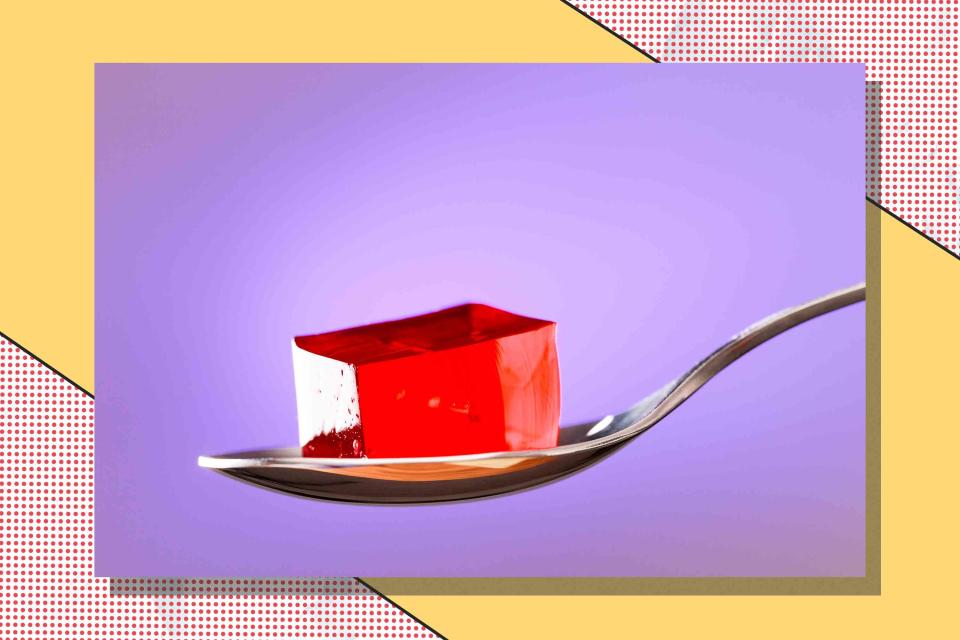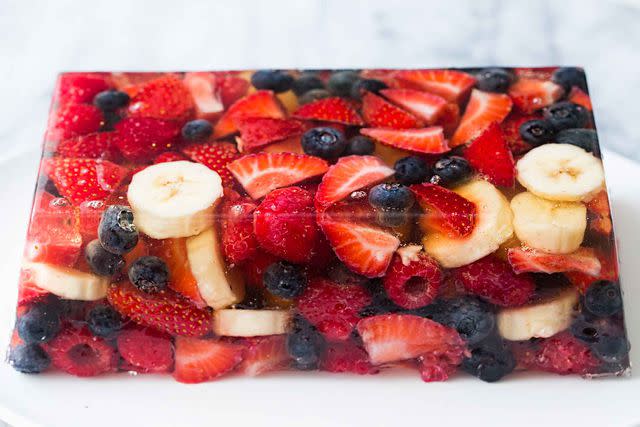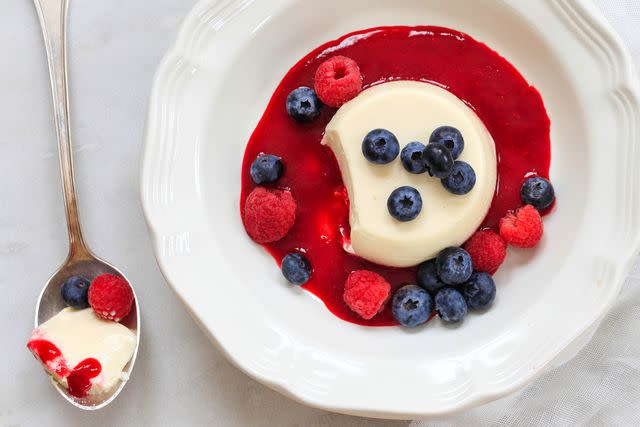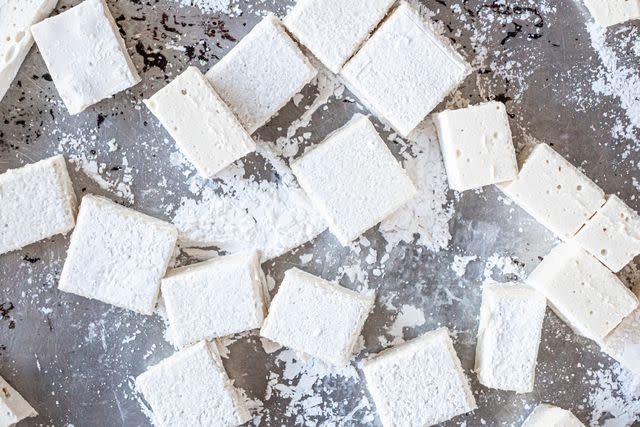What Is Gelatin Made Of?
Surprise! Gelatin is definitely not vegetarian. Here's why.

Wanda Abraham / Getty Images
Gelatin is such a neutral-seeming food. Once prepared, it wobbles and glistens so innocently.
The powdered form of gelatin used in the US is only a recent chapter in gelatin’s history. How is it made? Is it kosher? Is it vegetarian? Are there vegan alternatives? We are here to help you navigate the surprisingly complex world of gelatin with confidence.
Is All Gelatin Made From Animals?
The answer is no, but that’s a soft no. Most gelatin is indeed made from animals—their skin, bones, and connective tissue, to be specific. And most of the products that include gelatin (such as gummy bears and marshmallows) use gelatin that’s not vegetarian or kosher.
There are alternatives to gelatin to look for in products or use in recipes, and we’ll get to those in a moment.
How Gelatin Is Made
The foundation of the good old gelatin you’re most likely familiar with is a naturally occurring protein called collagen. It’s most plentiful in connective tissue (ligaments, cartilage, and bones) as well as skin. To extract the collagen, these items are boiled in liquid for a long period. Have you ever made chicken soup from scratch and had the leftover soup set up like gelatin in the fridge? That’s because, in essence, you made your own gelatin by simmering the chicken in water. This is why stock has a more luxurious mouthfeel when it’s made with bones and skin as opposed to just meat.
Commercial gelatin production is much different–it’s more industrialized and way less folksy than me letting chicken stock simmer for hours on a Sunday. Manufacturers extract, concentrate, and process the animal parts so the result has a neutral flavor, is easy to store, and sets up clear. Most commercial gelatin is made from cows and pigs, but fish are sometimes used. Sadly, I haven’t been invited to tour a gelatin factory, so I can’t confidently get into specifics beyond that.

Simply Recipes / Elise Bauer
The History of Gelatin
Gelatin is an ingredient that we think of as commonplace, but centuries ago it was a luxury. In the years before the advent of powdered gelatin, it took tons of time, labor, fuel, and animal parts to make a refined gelatin. Back in those days it was called aspic, and instead of dessert, it was most often used in savory dishes.
Aspic was not an everyday food, but a specialty for the upper classes. In classical French cuisine, pâtes and forcemeats were sometimes glazed with aspic for a striking presentation. Dishes like beef tongue in aspic might seem outrageous to us now, but they used to be showstoppers.
Gelatin came to the masses in the 19th century. In the mid-1800s, scientists on both sides of the Atlantic were innovating ways to make shelf-stable gelatin in various forms. The first available to cooks on the US market was Charles Knox’s unflavored gelatin in 1894. In 1895, Pearl and May Wait experimented with adding fruit flavoring and sugar to powdered gelatin, but they didn’t meet success with their venture.
The formula changed hands a few times, and in 1899 Francis Woodward bought both the Jell-O business and name. An aggressive marketing campaign combined with advances in home refrigeration made Jell-O a runaway success. Cue the ubiquitous mid-century salad molds that still make cameos at potlucks today. (I’ve had our carrot-laced sunshine salad, and know what? It’s pretty good!)
Forms of Gelatin
Most of the traditional gelatin in the US is powdered, whether in a flavored mix (like Jell-O) or unflavored (like Knox). Sheet gelatin, which is pliable and looks like quilted plexiglass, is more common in Europe. Chefs prefer sheet gelatin for its superior flavor and texture.

Simply Recipes / Sally Vargas
Foods That May Contain Animal-Derived Gelatin
There’s a decent list of ready-to-use products that often contain gelatin: some obvious, others not. When in doubt, look at the ingredients. (Also, I am SO BUMMED that frosted Pop-Tarts are technically not vegetarian.)
Marshmallows and marshmallow cream
Peeps
Jell-O
Candy corn
Prepared Rice Krispies treats
Kellogg’s Pop-Tarts (the frosted varieties)
Kellog’s Frosted Mini-Wheats
Altoids breath mints
A few brands of chewing gum, such as Ice Breakers
Starbursts
Gummy candies like gummy bears and gummy worms
Gel caps on various vitamin supplements and medications
Vegan Gelatin
Probably the most familiar and accessible vegan gelatin alternative is agar agar, an extract of red algae. It’s what makes our delightful vegan marshmallows recipe possible. Agar agar has a different mouthfeel from animal gelatin–it’s firmer and does not melt as easily, but it can be used to very satisfying results when handled properly. You can get agar agar in powder, flakes, or a honeycomb-like solid that slightly resembles a loofah. The powdered form is easiest to use.
Another option is carrageenan, a dried seaweed extract. Pectin, which is derived from fruit, will also work in some applications.

Simply Recipes / Elana Lepkowski
Kosher Gelatin
Since pigs are used as a gelatin source, those keeping kosher need to seek kosher gelatin–but there’s way more to it than that. According to Rabbi Sholom Ber Hendel on OK Kosher Certification’s website, “In order for the gelatin to be kosher certified, it must be made from kosher animals that underwent kosher slaughter and processing, or from kosher fish.”
There are other factors at play, too, but in short, as with all things kosher it depends on the context. Vegan gelatin is not automatically kosher unless it’s been certified kosher. Ditto for fish gelatin or all-beef gelatin.
Halal Gelatin
Because gelatin is derived from animals, in order for it to be halal, it needs to be made from halal animals. Since the animal sources of gelatin are not easily evident from just reading the ingredients on the product package, people seeking Halal gelatin should avoid processed foods containing gelatin unless it's clear from the labeling that the product is certified halal. For recipes calling for gelatin, use gelatin that's certified halal.
Gelatin Swaps
Any animal-derived gelatin (whether powder or sheets) should work in a recipe calling for gelatin. Gelatin powder and sheets need to be treated differently, so if swapping one for another, look on the package to see if it offers conversions and prep tips.
Since vegan gelatin alternatives don’t behave the same way as animal-derived gelatin, you should seek out a recipe that calls specifically for that ingredient. Once you get a feel for how agar agar, carrageenan, or other gelatin alternatives work, you can experiment with making adaptations for other recipes.
Recipes With Gelatin
Read the original article on Simply Recipes.

